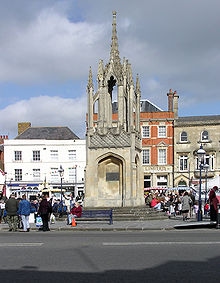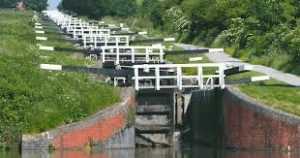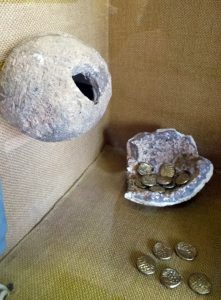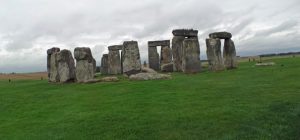No 548 NOVEMBER 2016 Edited by Micky Watkins
Lectures start at 7.45 for 8.00pm in the Drawing Room, Avenue House, 17 East End Road,
Finchley N3 3QE. Buses 82, 143, 326 & 460 pass close by, and it is five to ten minutes’ walk from Finchley Central Station (Northern Line). Tea/coffee and biscuits follow the talk.
Tuesday 8th November 2016: The Cheapside Hoard, by Hazel Forsyth
Tuesday 10th January 2017: My Uncle, the Battle of Britain VC, by James Nicolson
Tuesday 14th February 2017: London Ceramics at time of the Great Fire, by Jacqui Pearce
Tuesday 14th March 2017: Bugging the Nazis in WW2: Trent Park’s Secret History, by Helen Fry
Tuesday 11th April 2017: to be confirmed
Tuesday 9th May 2017: to be confirmed
Tuesday 13th June 2017: ANNUAL GENERAL MEETING
Tuesday 10th October 2017: The Curtain Playhouse Excavations, by Heather Knight, MOLA
Tuesday 14th November 2017: The Battle of Barnet Project, by Sam Wilson
HADAS CHRISTMAS PARTY
This year’s party will take place in the drawing room at Avenue House, where we hold our lectures, on Sunday 11th December from 12:30 to 4:00p.m. A booking form accompanies this newsletter. Regrettably, the cost of the room hire and the food have risen so the price will be £30 per person. This cost includes the buffet lunch and the first drink.
Payment is required by Friday 18th November, but you can reserve your place early by notifying Jo or Jim Nelhams – contact information at the end of the newsletter.
The Long Trip, 2016 Jim Nelhams
On Monday 19th September. an intrepid group of 38 members, partners and friends headed west by coach for our annual long trip – this year based at the Best Western Leigh Park Country House Hotel on the outskirts of Bradford on Avon, near Bath. The Hotel, having accepted another group following our booking, were short of rooms, so we arranged for 5 extra rooms in a neighbouring converted barn. Our thanks to those who used that facility.
After a brief comfort stop on route, we headed to the town of Devizes, where the coach dropped us at the Wiltshire Museum. Here we met up with Beverley Perkins and David Bromley, who moved a few years ago to Devon but have remained members. They joined us for the remainder of the trip. A bonus at the Museum, was meeting up with long standing member Sigrid Padel. Sigrid moved in the summer to the New Forest, but drove up to spend time with us. It’s so nice to see old friends and good that they keep in touch. And later in the week we planned to meet up with David and Emma Robinson – more of that to come.
Devizes Jim Nelhams
Devizes is a market town and civil parish in the heart of Wiltshire. Its castle, started in 1080, was destroyed in the civil war in 1648 on the orders of Cromwell. It was later reconstructed in private hands and now contains flats, so is not accessible to the public.
The town now has four Church of England parish churches, and we visited the church of St John the Baptist, close to the museum. St John’s also stands close to the castle and may have begun as its chapel. The oldest parts of the building are from 1130, shortly after Roger, Bishop of Salisbury, rebuilt the castle. Pevsner writes “A major Norman church, dominated by a mighty crossing tower …”
The western part of the church was rebuilt in the 15th century with restoration carried out in 1844 and 1862-3, including the west front designed by Slater. The ornate Beauchamp south chapel is similar to the 1492 Beauchamp and Tocotes chapel at Bromham; the north Lamb chapel has a fine panelled ceiling. The organ case is late 17th century.
On the north side of the churchyard is a millennium cross, erected in 2000, with panels showing local scenes and trades. The museum had kindly arranged for us to park our coach at the Wadworth Brewery at the opposite end of the town, providing a target for our walk through the town market place
The Wadworth Brewery sits at the north end of the town. The company was established in 1875 when it purchased the Northgate Brewery, and moved to the current site to allow expansion. The brewery still uses two of the very few remaining ‘working’ Shires in the brewing industry in Britain to deliver beers, wines and spirits on weekdays (weather permitting) to pubs within a two mile radius of the Brewery. Working as a pair; they are able to transport a load of approximately two tons.
 The first known market in Devizes was in 1228. The original market was in the large space outside St Mary’s Church, rather than in the current Market Place, which at that time would have been within the castle’s outer bailey.
The first known market in Devizes was in 1228. The original market was in the large space outside St Mary’s Church, rather than in the current Market Place, which at that time would have been within the castle’s outer bailey.
The chief products in the 16th and early 17th centuries were wheat, wool and yarn, with cheese, bacon and butter increasing in importance later.
In the early 18th century Devizes held the largest corn market in the West Country and also traded hops, cattle, horses and various types of cloth. Before the Corn Exchange was built in 1857, the trade in wheat and barley was conducted in the open, with sacks piled around the Market Cross.
The town sits on top of a hill and such was its importance that the Kennet and Avon canal which links Bristol to London, opened in 1810, was routed up the hill and through the town. A total of 29 locks raise the canal including a flight of 16 locks mounting Caen Hill. On the canal quay is a small museum run by the Kennet and Avon Canal Trust, giving information about the development of the canal, its falling out of use, and the subsequent restoration, as with many canals, following the efforts of hundreds of volunteers. It also includes working models of the Crofton pumping station which we visited in 2015 and the pumping station at Claverton we would visit later in the trip.
 Leaving the brewery in our coach (a few more horsepower), we made a brief stop at the foot of the
Leaving the brewery in our coach (a few more horsepower), we made a brief stop at the foot of the
Caen Hill flight of locks to provide a chance for photographs. Thence onwards to our hotel in Bradford on Avon, passing through Melksham where an Hawker Hunter jet fighter stood at the side of the road.
Devizes Museum Don Cooper
Devizes Museum, more correctly called Wiltshire Museum (it is the county museum), is housed in two Grade II listed early Georgian town houses with a Victorian infill and modern additions. The modern additions include lifts and ramps to all floors and up-to-date toilets. The museum concentrates on Wiltshire county heritage and is organised by time periods, although Upper Floor C tells the story of Devizes. The museum is a charity and dates from 1853.
All time periods are well represented with the four “Prehistoric Wiltshire” rooms being particularly good, highlighting the rich prehistoric landscape of Wiltshire which includes Stonehenge and Avebury.
However, the item that caught my eye was a fossil – a sponge fossil. These sponge fossils seem to have been put to a number of uses.
Some have been found used as money storage or perhaps money boxes (see photo). The Celtic gold coins are replicas of the ones found and there have been at least two other sponge fossils found that had been used for this purpose. The coins were Iron Age and were found at Chute in 1927 and more in 1986 and 1994.
 Another use illustrated was pigment holders. These fossils when split in half make a good small mixing bowl when applying colour to an object.In the prehistoric gallery there was a beautifully shaped sponge fossil used to make the head of a mace. It had been partly drilled through and polished, giving the head of the mace a striking look.
Another use illustrated was pigment holders. These fossils when split in half make a good small mixing bowl when applying colour to an object.In the prehistoric gallery there was a beautifully shaped sponge fossil used to make the head of a mace. It had been partly drilled through and polished, giving the head of the mace a striking look.
Figure 1 Sponge fossil used as a money box .
The museum is representative of the best kind of county museum. The artefacts are well labelled, the staff helpful and friendly, and there is a good selection of local books and guides. This visit was a great start to our stay in Wiltshire.
AUTUMN TRIP 2017
Although we have only just returned from our trip to Bradford on Avon, hotels are requiring that bookings for groups are made well in advance. So we are happy to announce that the trip next year will run from Monday 25th to Friday 29th September based at the Best Western Forest Hills Hotel in Frodsham, close to Liverpool and Chester. For the more energetic, the hotel boasts a gym, sauna, jacuzzi and swimming pool.
Prices will remain as this year at £470 per person sharing a twin/double room and £520 per person in a single room. A deposit of £125 per person will be required next March.
This year, several members brought friends on the trip, which is good because it helps share the cost of the coach and keeps the price down. They are more than welcome.
Please let Jo or Jim Nelhams know if you are hoping to come – so that we can reserve sufficient rooms. Contact details are at the end of this newsletter.
Bristol – The Avon Gorge and Henrietta Barnett Micky Watkins
In the 1890s, Henrietta and her husband Canon Samuel Barnett visited Bristol for three months every summer because Samuel was made a Canon of Bristol Cathedral. It was a welcome change from their life and work in the slums of Whitechapel. They used to walk and bicycle in the surrounding countryside. Henrietta saw that the Avon gorge was defaced by stone-quarrying, bare expanses of stone overtaking the woodland. Henrietta, with her secretary Marion Paterson and her adopted daughter Dorothy and friend, scattered flower seeds on the cliffs:
“First the seeds had to be collected; and then in the back garden, the children and I mixed them with earth, stirring all sorts together in the breadpan in Christmas pudding style. Then the packets were made about the size of a tennis ball and tied up in newspaper, and in the evening, in the gloaming, we went out like four conspirators down over the rocks.
Samuel carried the heavy baskets for them but would not throw the parcels because it was illegal. They were all delighted when “the bare rock produced antirrhinum, valerian, yellow alyssum, wild convolvulus, and, undoubted proof that they were the babes of our balls, Iceland poppies of the same strains as grew in our garden.”
The cliffs of the Gorge were purchased by George Wills, cigarette millionaire, to give to the public. When we approached the bridge we saw information about the flora of the cliffs, and the importance of this site of scientific interest. But no mention of Henrietta!
Battle of Barnet snippet Don Cooper
From the Barnet Museum & Local History Museum – August 2016 edition, a report on the Battle of Britain Project:
“In May a team of volunteers helped Sam Wilson [the project leader] with test-pitting in the area that used to be Kitts End Hamlet to try and establish how old the settlement was. They found lots of fragments of pottery and tile which have been dated by the British Museum to the whole medieval period (C11th to C15th), which indicates that the settlement was in existence at the time of the
Battle of Barnet.”
 Stonehenge at Risk? Micky Watkins
Stonehenge at Risk? Micky Watkins
Archaeologists and conservation groups are deeply split in their views about the Government announcement of the proposal to bury the A303 in a tunnel under Stonehenge.
English Heritage and the National Trust – owners of the site and the surrounding landscape – are jubilant. But Kate Fielden, representing the Stonehenge Alliance of conservation groups, Friends of the Earth the archaeological group Rescue and Aslan – whose members include pagans and Druids – all say that this short tunnel will cause serious damage to the historic landscape on each side.
Anyone who has used the A303 in the summer will know that the traffic jams extend for miles each side of Stonehenge and something must be done. More acceptable solutions are to make a longer tunnel, or by-pass the site, possibly using the A30 which runs parallel to the A303.
King Arthur’s Palace
A royal palace dating from the 6th century has been discovered at Tintagel. This is the probably the birthplace of the legendary King Arthur.
Cornwall Archaeological Unit is excavating the site. They have found many fragments of pottery and glass which had been imported from Europe and the Middle East by the wealthy people who lived here. There are sherds of imported late-Roman amphorae, fragments of fine glass and of Phocaean red slip-ware which was made in Turkey. In exchange, tin was exported from Cornwall.
Tintagel is one of the most important sites in Europe. Here the Romano-British rulers fought the Anglo-Saxon invaders for control of the island in the fifth century. The castle was built later, in the 1230-40s, by Richard, Earl of Cornwall, brother of Henry III.
Surely Arthur must have lived, for in the sixth century the monk Gildas wrote about him. If Gildas was fabricating a history it would have been disproved by old people with long memories. (Ed’s note: Arthur is not mentioned in Gildas)
The team is supported by English Heritage and this three week dig will be followed by further digs for the next four years.
Newly Excavated 1st Century Roman Bath in Pompeii
The entrance to the bath is through a portico from which you walk through to the changing room which is frescoed with eight numbered erotic scenes of different positions. Above the baths were prostitutes’ rooms. The changing room is floored with marble and the ceiling has stucco reliefs of cherubs and chariots. The cold plunge pool is frescoed with seascapes.
Other newly opened buildings are a merchant’s richly decorated house, a middle class house and a business where the people brought their fabrics to be cared for (dry-cleaners?).
The baths were badly damaged by the earthquake of 62 AD and were still being repaired at the time of the eruption of Vesuvius in 79AD which accounts for the absence of any statues or furniture.
OTHER SOCIETIES’ EVENTS Eric Morgan
Friday 4th November, 7.30 pm. Barnet History Society, Chipping Barnet Library. Gillian Gear Memorial Lecture: Warwick’s War by Karen Clark. Visitors £5.
Wednesday 16th November, 7.30pm. Willesden Local History Society, St Mary’s Church Hall, Neasden Lane, NW10 2TS (near Magistrates’ Court). The Willesden Green Cat Mosaic. Talk by Debra Collis.
Wednesday 30th November – Tuesday 6th December. Barnet Borough Arts Council, The Spires, High St., Barnet EN5 5XY. Art & Info. Exhibition (incl. HADAS details). Part of Barnet Xmas Fair, showing paintings, prints, photographs and textiles.
Friday 2nd December, 7.30 pm. Wembley History Society. English Martyr’s Hall, Chalkhill Rd, Wembley HA9 9EW (top of Blackbird Hill, adj. to church). The Forgotten Industries of Old Kingsbury and Hendon. Talk by Jim Moher, followed by mince pies. £3.
Saturday 3rd December, 9.45 am.-5 pm. Thames Discovery Programme, Foreshore Forum, National Maritime Museum, Greenwich SE10 9NS. Hear Updates from Frog Teams and Speakers. Tickets £20 & booking fee from:
www.thamesdiscovery.org/events/foreshore-forum-2016
Wednesday 7th December 6pm. Gresham College at Museum of London. Tough Choices: Heritage or Housing? Talk by Dr Simon Thurley. Free.
Monday 12th December, 5.30 pm. Society for Post-Medieval Archaeology, Society of Antiquaries, Burlington House, Picadilly. AGM followed by 6pm drinks reception, then 7pm. The Great Wall and the Ceramics Trade, by David Barker. Free, but book at:
www.spma.org.uk
Tuesday 13th December, 6.30 pm. LAMAS, Clore Learning Centre, Museum of London.
Investigations on the Site of Shene Charterhouse undertaken by MOLA and Richmond Archaeological Society in 2011-15. Talk by Bob Cowie (MOLA). Visitors £2. Refreshments from 6 pm.
Tuesday 13th December, 7.45 pm. Amateur Geological Society, The Parlour, St Margaret’s Church, Victoria Avenue, N3 1BD (off Hendon Lane). Our Heritage – Stone Tools and Rock Art. Talk by Bob Harris.
Wednesday 14th December, 2.30 pm. Mill Hill Historical Society, Trinity Church, The Broadway NW7. Whitefriars Glass – The Harrow Years. Talk by Mike Beech.
Comments

